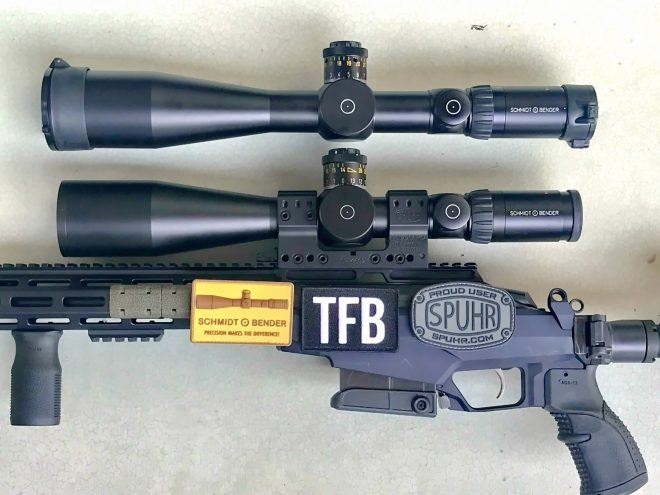This is an extended review of the Schmidt & Bender 5-25×56 PMII rifle scope with the LRR-MIL reticle in a Spuhr SP-4602 mount.
When I think of it, the Schmidt & Bender 5-25×56 PMII is probably one of the most expensive products we at TFB have ever tested. For sure it has got to be one of the most expensive rifle scopes we ever laid our hands on.
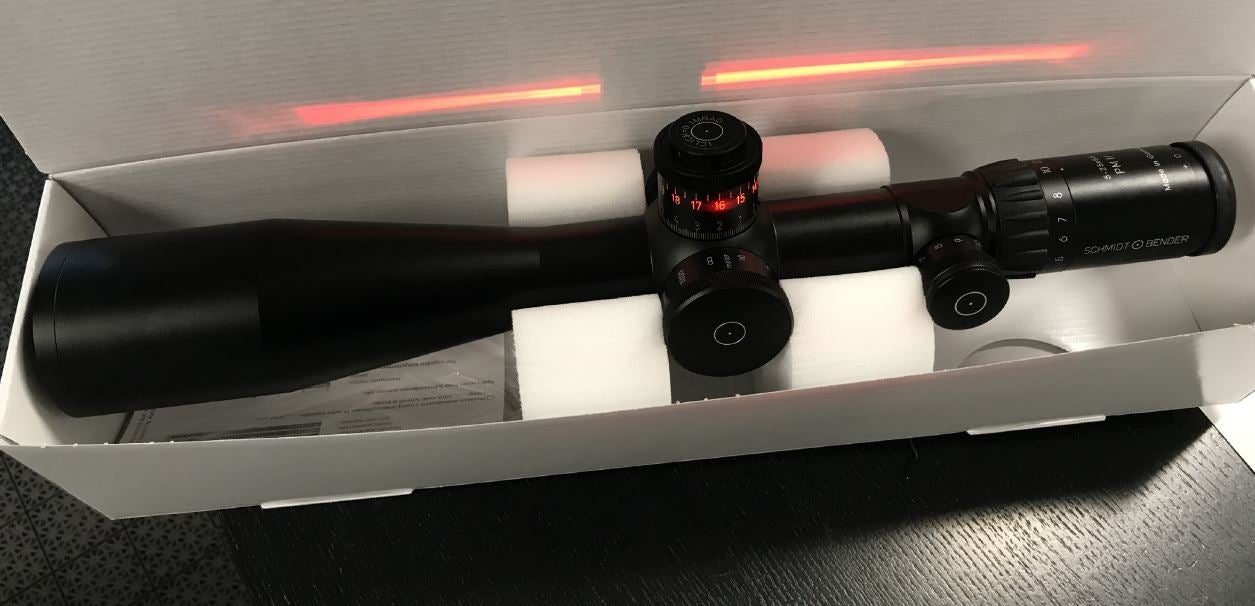
Usually, we keep the pricing of a product until the end of a review, but why wait? Depending on the configuration, the S&B 5-25 PMIIs are around 3,200 to 4,000 USD.
Below: Yes, the instructions are available in English as well. The light comes from a bar code scanner that happened to activate as I was taking the pictures, creating a nice effect.
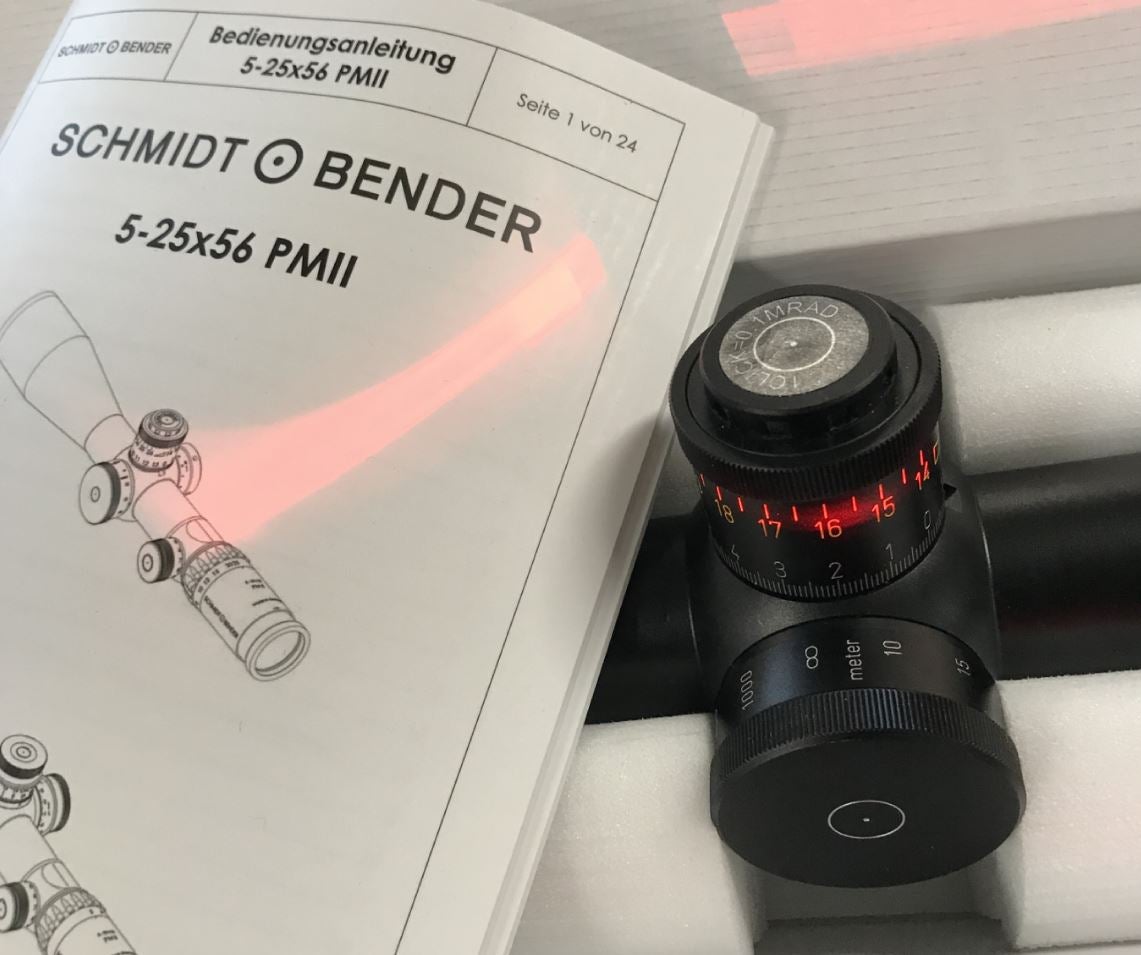
Schmidt & Bender in Germany were kind enough to let me try it over a long period of time. Of course, the 5-25 PMII model is by no means new, it’s been around for some time. However, the reticle LRR-MIL is a brand new offering. The Long Range Reticle – Milliradian (LRR-Mil) was specially developed for shooting at long distances.

The center dot and center cross can be illuminated. There is ultra-fine dot center aiming point, which covers 1,6 mm at 100 meters only.
So we’re going to look at the LRR-MIL reticle and how the scope is keeping up. Is it getting too old compared with newer models and competitors? Or is older better and wiser?

S&B 5-25×56 PMII besides a Swarovski Z6i 1-6×24 Gen 1.
Background
I have an S&B 3-12x PMII and an S&B 5-20x Ultra Short PMII in my possession already, so I’m fairly aquainted with the brand and the design. For the record, both were bought second hand by a friend who didn’t know better. The 5-20 Ultra Short scope transforms my JP Rifles 18″ CTR-02 (AR15) from a sporting rifle to a sniper rifle. It’s accurate enough with a 6-8x power scope, but with the S&B 5-20x, I’m shooting 5 round 46 mm groups (1.8″) at 300 meters (328 yards). That’s with GGG 69 grains .223 Rem ammunition.

For the fun of it, I actually shoot the JP CTR-02 in the local 300-meter matches, and I took it to one of the Viking Rifles Series (Nordic Precision Rifle Series) up to 500 meters, placing around mid-field.
Testing Platform
However, the Schmidt & Bender 5-25×56 PMII deserves to sit on a different kind of Beast. Something that can reach out a bit further, so I mounted it on my Tikka T3x TAC A1 in 6.5 Creedmoor.
The Spuhr SP-4602 mount is an excellent companion for this sight, and Spuhr were kind to let us evaluate them together.

Tikka T3x TAC A1 in 6.5 Creedmoor
The Scope: Schmidt & Bender 5-25×56 PM II
As this model has been around for some time we’re not going to dig too deep into the details of the optics. The brand and model is very well known for setting the benchmark for the industry in terms of optical quality and mechanical reliability.
The Schmidt & Bender 5-25×56 PMII has been supplied to the Special Forces of Army, Navy, Air Force and Marines since 2011. If you ever see a Special Forces or Police Sniper on the news you can place a rather safe bet that they’re using any of their PMII models.
Just check our article on the “Rifles & Optics of the European Best Sniper Squad Competition 2016“, where the conclusion was that the military snipers were mainly using optics made by Schmidt & Bender.

One of the early S&B 5-25×56 PMIIs, on an Accuracy International AI AW in .308 Win. This concept is still going strong and is used both for hunting and long-range target shooting.
The ergonomics and fonts may look a bit German and dated, but the feel and the “clicks” are just right for this type of scope. There isn’t anything unnecessary around, and if we think for a second that’s probably exactly what our brain is happiest with in a long-range shooting situation.
The zoom lever is rubberized for a great grip. Even the amount of force that is needed to adjust the magnification feels right. Quite a few scopes (including some S&B models) have zoom levers (or magnification change that S&B calls it) that need a lot of force to adjust them.
The eyebox
A very important factor on a rifle scope, especially for shooting in new and uncomfortable positions, is the eyebox. Think of the eyebox as a volume outside the scope, where you can keep your eye and still be able to see the target and shoot.
The larger the volume (“working area”), the more forgiving the scope will be to shoot. The larger the magnification, the smaller the eyebox will become. A high quality 1x power scope is going to be extremely forgiving, and a high quality long range high power scope on maximum is going to punish you unless you do things right. A low quality scope on maximum magnification is going to punish you even more, you’re going to look into a black hole most of the time until your eye is perfectly positioned.
Any shooter always wants a bigger eyebox, but the S&B PMII tested here passes with excellence in my opinion. At high magnification the eyebox is tight, there’s no magic. But if you’re going to ring steel at 1 000 yards consistently you are going to have to place yourself in a good, repeatable position anyway.
For a deeper explaination of the eyebox you can check this video (Understanding Eye Box, and More, with Leupold).
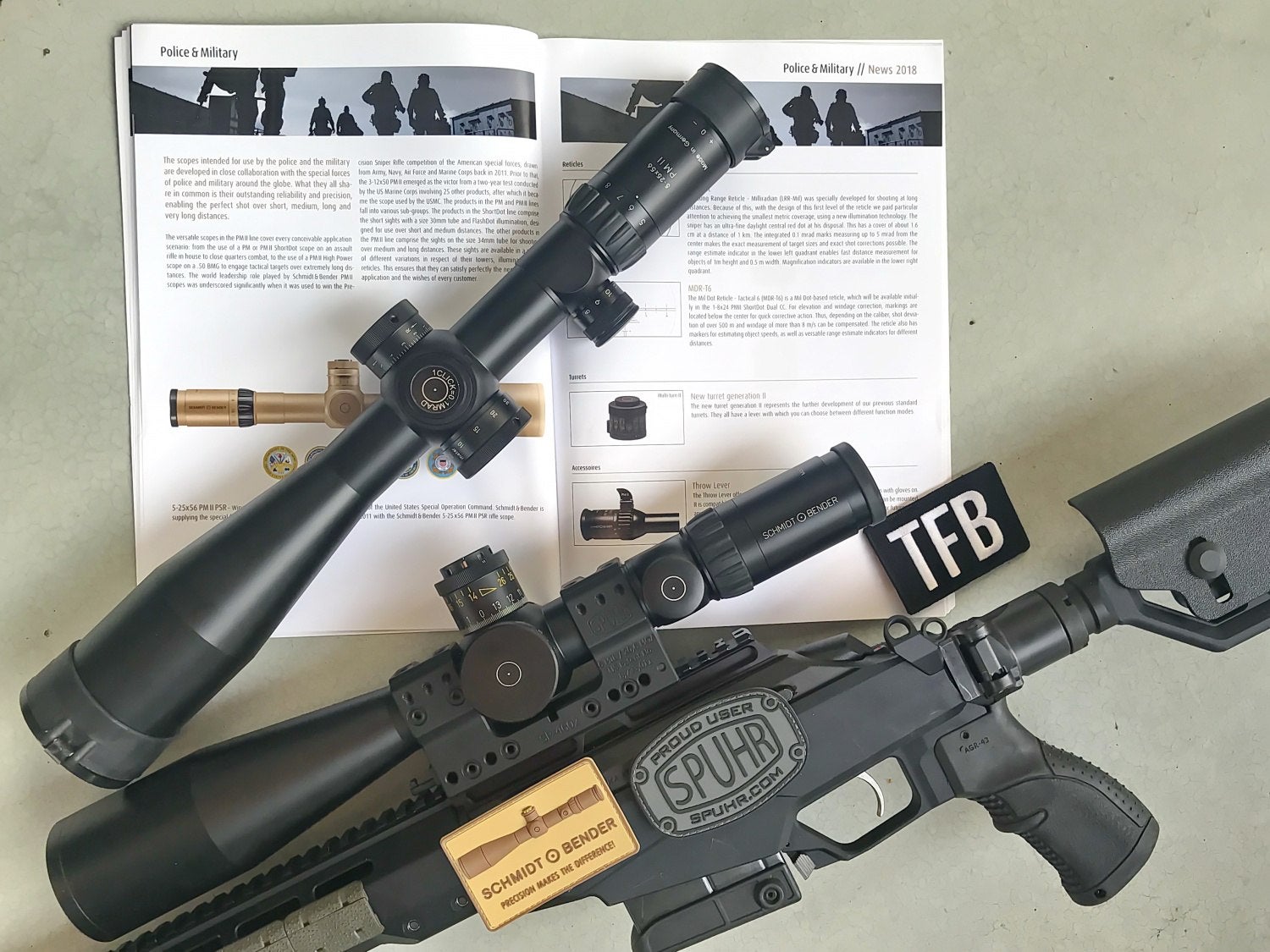
Internet is a great source of information, but sometimes an old fashioned catalogue is better.
The scope tested had the “Double Turn with visual indicator” turret. It has two turns, and the transition to the second turn is clearly shown as the top of the turret goes from black to yellow.
If I specified my own S&B scope I would definetly go for the MTC/LT turret, which is short for “More Tactile Clicks/Locking Turret”. I have this one my S&B 5-20 Short Dot, and it’s a great help if you need to adjust your scope between long distances. S&B describes it as follows:
The shooter has two turns available for elevation adjustment, the so called Double Turn turret. Here, a tactile rotational indicator appears on the top of the turret during the transition to the second rotation. In addition, at every 10:th click, the tactile response is more pronounced, making fast adjustment possible without having to look at the turret. The locking action is triggered by pulling up the outer ring of the turret, and it is set by pressing it down again. A red symbol indicates the locked position.
I would also get a throw lever of some sort, just to make it a little bit easier to adjust the magnification from the prone position or if you’re wearing gloves. Either S&Bs own or the one from Throwlevers.com (see below).

I also spent some time shooting steel at longer distances, up to 800 meters. No photography was allowed on that range, but the scope and reticle worked fine. You can see an Instagram video below.

I use Strelok Pro as Ballistic calculator, with a Kestrel weather meter, and as you can see the LRR-MIL reticle is on there.

So far I never had to try S&B’s warranty, but for the record you can read the company’s statement on their homepage here. There is a service center in Germany and one in the USA.
The Reticle: Long Range Reticle – Milliradian (LRR-Mil)
Reticles are subjective and that’s why companies sometimes offer an abundance of them (but you’re still looking for the one they don’t offer, aren’t you?).
I am not saying you must like the LRR-MIL, because it may not be the right thing for your application or not what you’re used to. But please give it some time and I’ll try to explain how it works.
One of the problems with today’s super zoom, high power scopes is to get a reticle that is useable on all magnifications. The reticle on this scope is in the First Focal Plane, so it increases in size as you increase the magnification. A Second Focal Plane reticle appears to be the same size regardless of your zoom.
You want the best reticle at 5 power and the best at 25 power (magnification factor 5). Remember that S&B now offers up to a 3-27x and a 5-45x power scope as well (factor 9), where these issues only become bigger.
Below: Picture of the reticle at 5x and 25x Power to emphasize my text.

I have a tendency (which is a better word for “bad habit“) to use as high magnification as I possibly can. Of course, I lose some field of view, but it’s damn nice to see those hits in the steel. Mirage isn’t a huge problem where I live. And I like to be able to line-up the reticle along a patch at 100 meters, and see exactly where the bullet cuts the paper versus where I aimed. That is quite satisfying, and that feeling makes it worth buying high-quality optics.
I rarely use less than 10x power on these types of scopes, and it’s possibly due to the reticles getting the look of a plain crosshair rather than all those nice details the reticle can tell you once you get into what I consider being the “working zone” of the scope. I am more of a 15-20x power person (remember my S&B 5-20 PMII), so to be able to zoom in up to 25x was welcome.
Below: Here’s the field of view at 15x. As you can see there are three useful MILs if you need to hold under for some reason.

The cost is of course that the eye box is a little less forgiving, but on a bolt-action rifle, this is a price I’m prepared to pay unless the target array is very dynamic.
In short, the LRR-MIL reticle contains three major components. First, the main reticle, then the magnicifaction power identification indicator and the meter and half-meter ranging scale.
The last is an illuminated reticle. The center dot and center cross are the only portions of the reticle that illuminate. The reticle’s milliradian (mil) math is based upon the metric system, and references 0.1 mil, 0.2 mil, 0.5 mil, and whole mil increments throughout. (Example: 0.1 Mil = 1.0 centimeter at 100 meters AND 1.0 Mil = 10 centimeters at 100 meters).
With the formulas below and the measurements you make in the reticle you can do some “ballistic math”. Perhaps mathematical equations might become interesting for the first time in your life?

Below: The Schmidt & Bender PMII at power 25 on a sunny day, looking at a chimney at a distance of about 1,600 meters (1,750 yards). Reticle: LRR-MIL.
Please bear in mind that this photo is taken on a shaking iPhone 7, so in reality it looks much better. Getting good quality pictures through an optic is really difficult. The illumination on the reticle was off.
As a “sniper” you get an ultra-fine daylight central red dot at your disposal. The dot in the middle (hardly visible in the picture) cover only about 1.6 cm (0,62″) at a distance of 1 km (1 093 yards).

A chimney about 1,600 meters (1,750 yards) away.
Below you can compare the online pictures of the S&B reticle LRR-MIL versus actual shots taken by myself. Note the illuminated area (red).

The illumination is daylight visible, and very visible once you get it over a target. I didn’t notice any overwash.
The integrated 0.1 mrad marks measuring up to 5 mrad from the center makes the exact measurement of target sizes and exact shot corrections possible.
Below: Looking into the blue sky. The photo was taken with iPhone 7, free hand. In reality, the red appears much better, and the reticle is much crisper than I can recreate.
I really like the fact that the center is more or less free, so I can see the target and what’s behind. The P4L Fine reticles I’m used to in my other S&Bs sometimes hides this which is quite irritating on small steel targets with a similar grey-grey background. When you can no longer can see the target, that’s when you should pull the trigger to hit. I’m not too found of that.
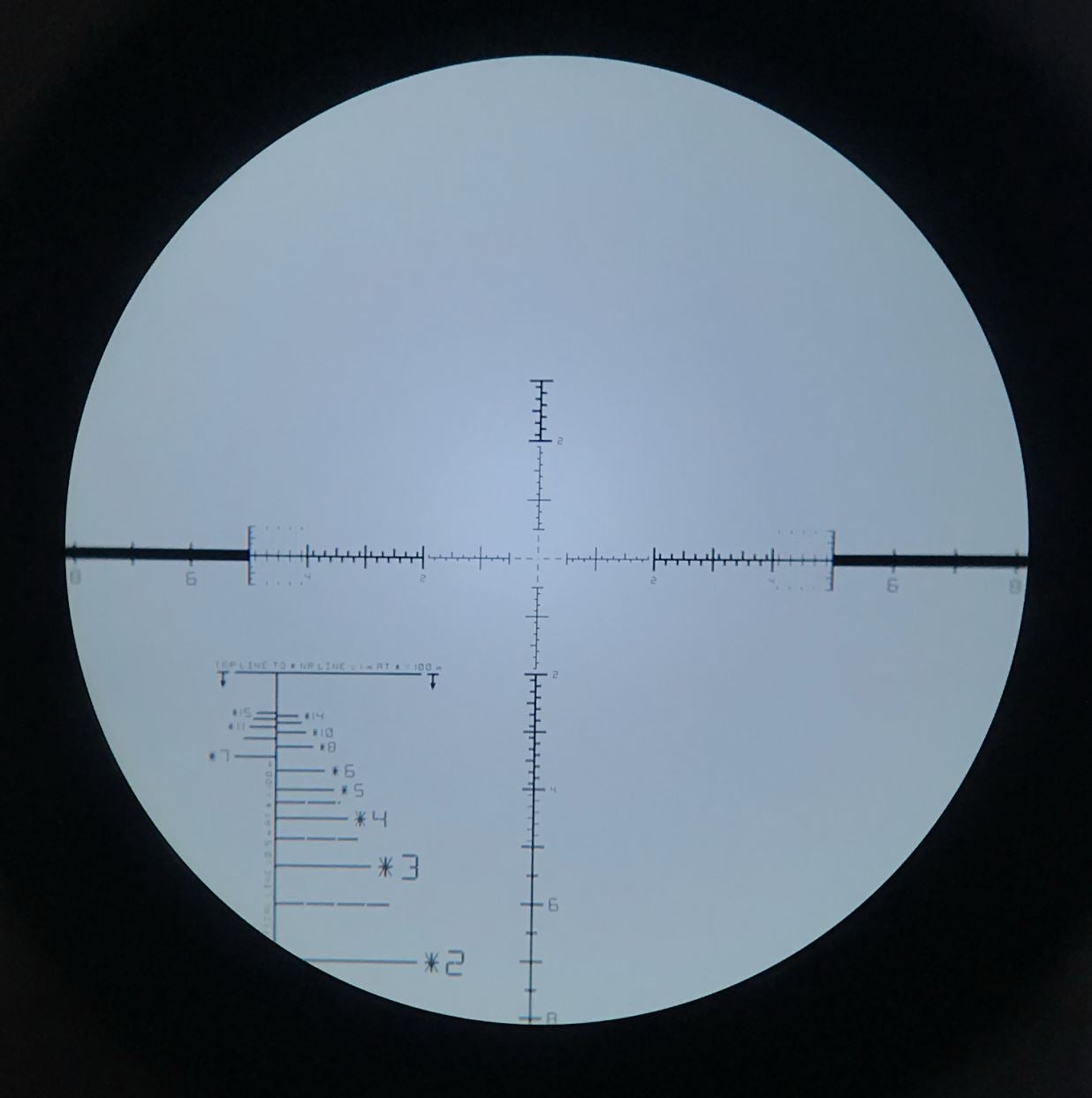
From the manual, with better visibility:
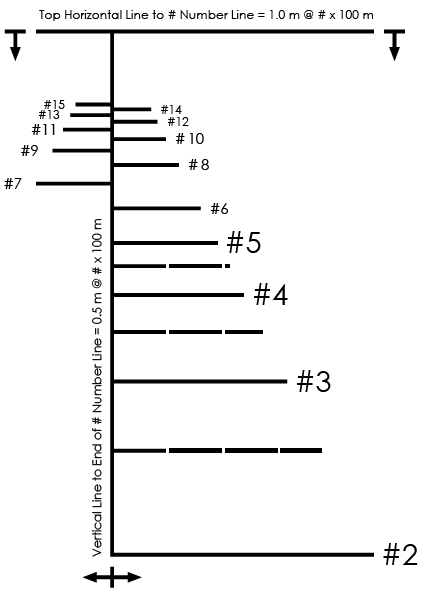
The LRR-Mil reticle has a clean, uncluttered and easy to understand meter and half-meter ranging scale, in the lower left quadrant. This ranging scale allows for a 200 meter to 1500 meter range estimating option.
We hade the opportunity to get better photos of the reticle in use from Longrange in Slovakia: https://www.longrange.sk/ The yellow thing is about 550 meters away (about 600 yards).

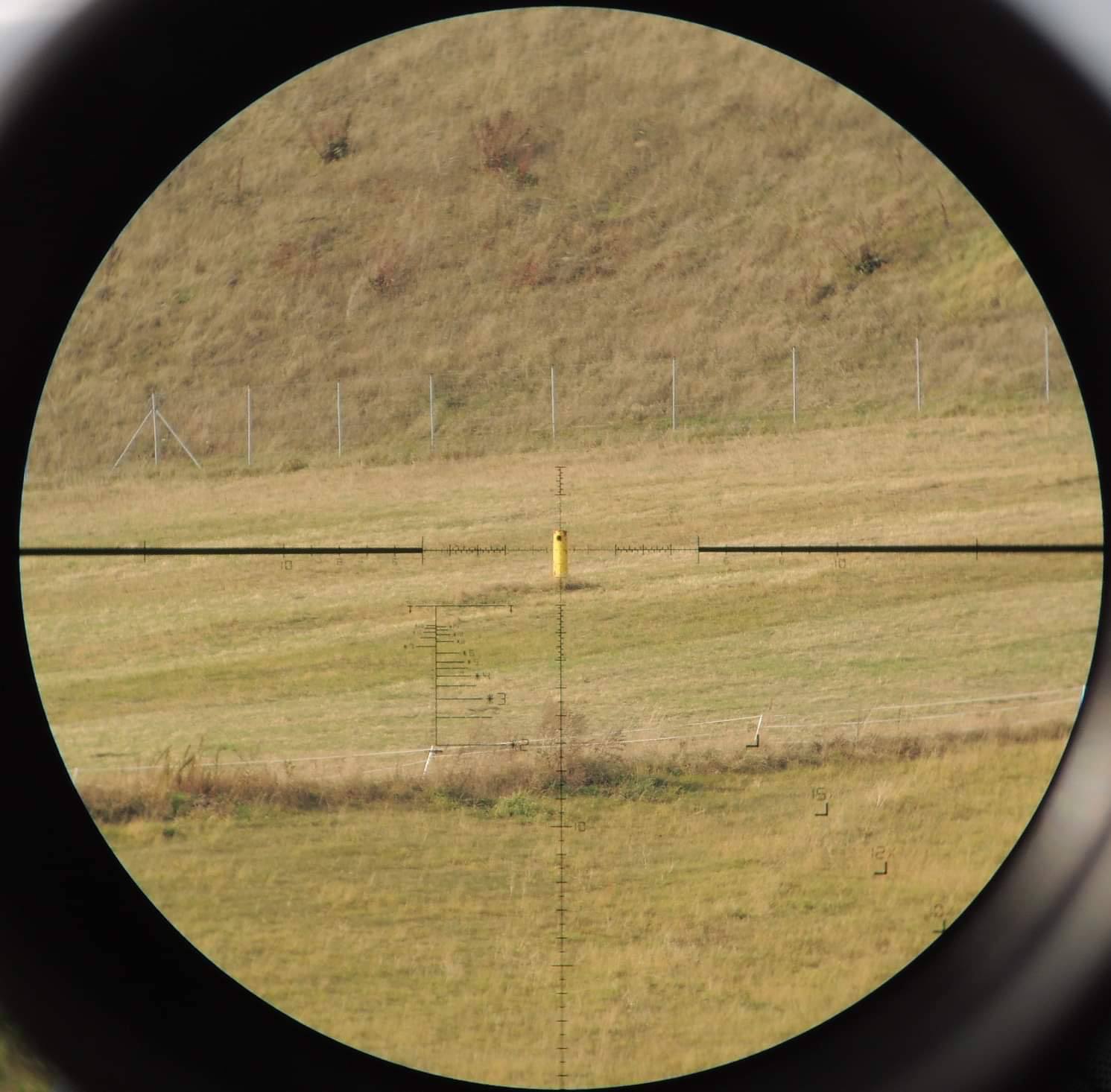

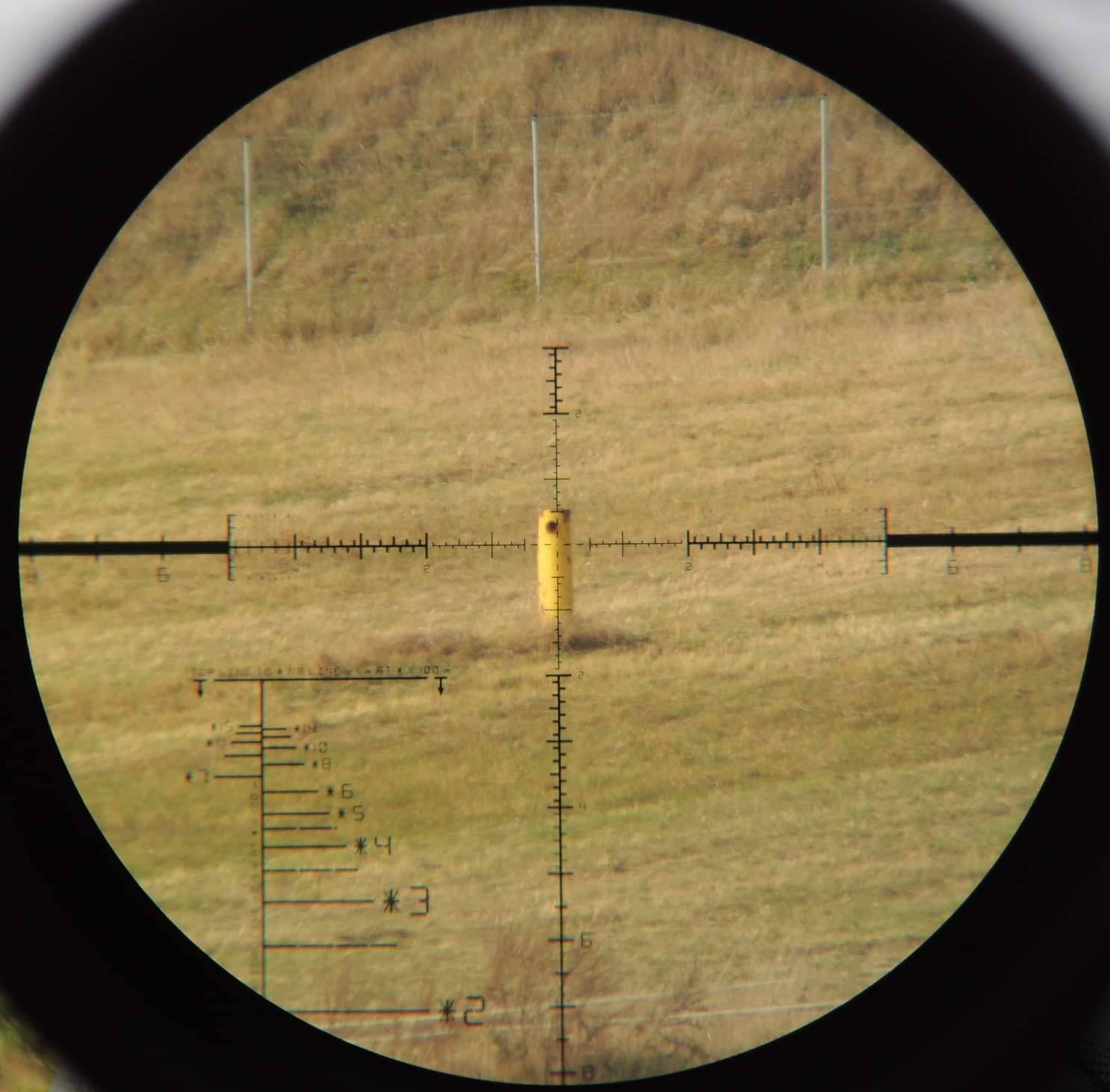
And with the reticle illuminated against a darker surface. Notice the tiny, tiny dot in the middle.

Translating the LRR-MIL reticle
Below you can see S&B’s “translator”. There are so many things you can measure here it made me dizzy at first. However, if you study it and do your homework it will start to make sense. If you learn it by heart, it’s going to do wonders.
Just look at “F”, which is the small dot in the middle. At 100 meters it covers 0.16 cm, or 1.6 millimeters!
At 100 yards it covers 0,06 inches or 0,02 MRAD!
No wonder I could “poke around” with the center dot in the black bullet holes of the 6.5 Creedmoor, which felt sensational. This was at 100 meters and at 25x power, and I’ve never seen this in other reticles.
The small center dot felt like having a super-sharp laser that I could place in the bullet hole I just made in the paper.

The range estimate indicator in the lower left quadrant enables fast distance measurement for objects of 1 m height and 0.5 m width. Magnification indicators are available in the lower right quadrant.
Below you can see a selection of images of the reticle. Again, please note that these are taken with an old iPhone 7, hand-held, and the optic appears much better in reality.
Below: Low magnification (exact unknown). IPSC Full-sized Targets at 100 meters, as well as ultra-small ones with painted dots on them (not IPSC competition approved) and 10 m air rifle targets (14×14 cm, center dot is 35 mm / 1.35″)

Below: and 25x, with illumination. Notice how the iPhone 7 doesn’t pick up the center dot of the reticle, as it’s most likely too small or is lost in the software processing somewhere.

Below: Again, the center dot is not visible on the camera. Bottom right is a 10 m air rifle targets (14×14 cm, center dot is 35 mm / 1.35″).
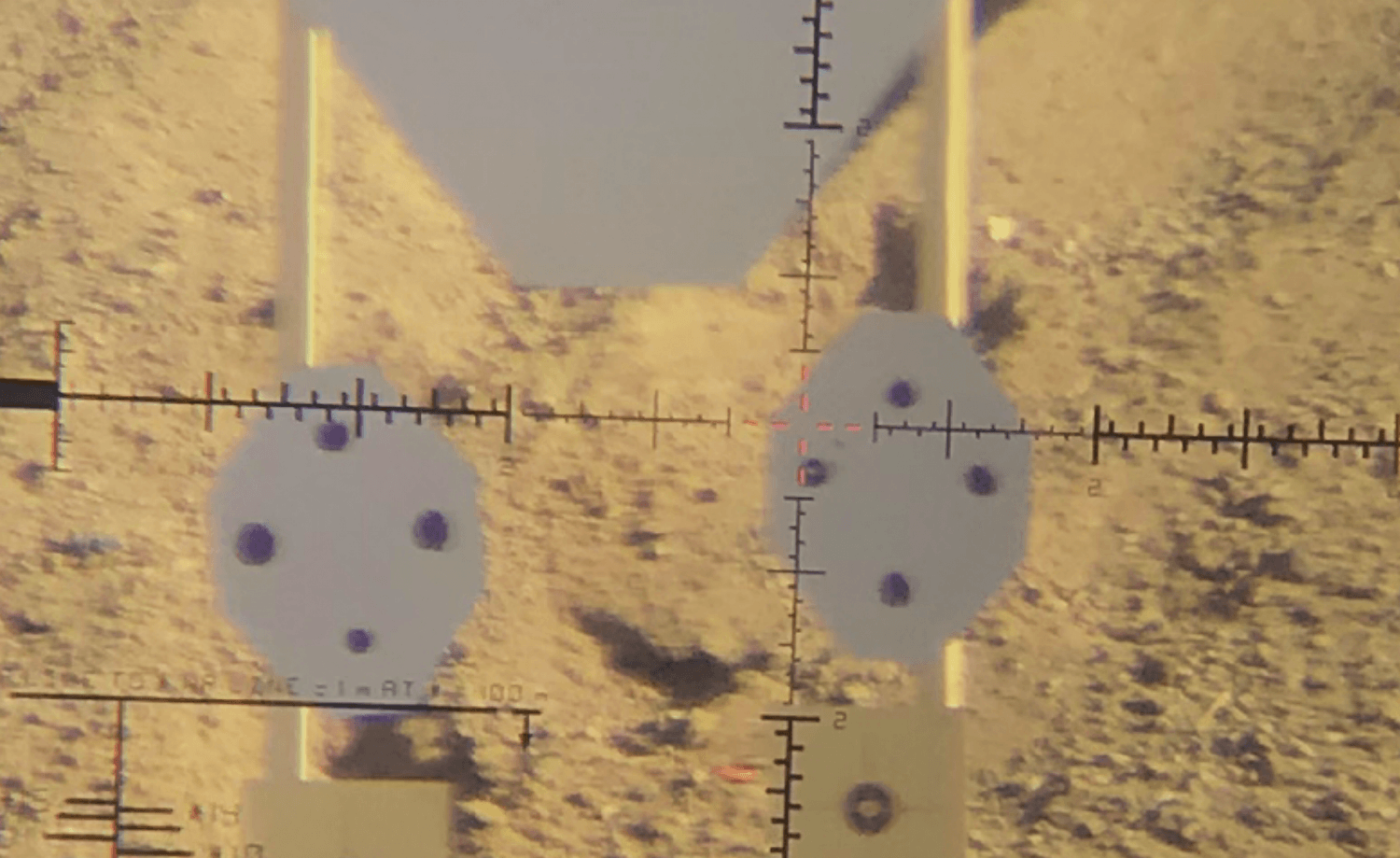
Note the “FINE GRADUATED RANGING AND ESTIMATING BOX”. (It’s not really useable at 100 meters)

On the horizontal reticle, beginning at the 4.0 mil mark, and extending to the 5.0 mil mark, at both the 3 and 9 o’clock positions, there is a fine graduated ranging and estimating box, consisting of 0.1, 0.2, 0.5, and 1.0 mil graduations for reference. This is for assistance in dealing with very distant or small targets. On the 6 o’clock vertical leg, beginning at the 5.0 mil mark, the reticle has 0.5 mil and 1.0 mil graduation marks down the remaining portion of the reticle.
For full details on the LRR-MIL reticle please check S&Bs own datasheet pdf here, where you can magnify the reticle better if you like.
Here is also a list of some of the reticles offered by S&B: check here.
TFB did a long article on Finnaccuracy’s Multipurpose Sniper Reticle II (MSR II) which you can check as a reference. It is also a contender to get the same job done.
Another recommended reticle would be the GR²ID for Practical Long Range Sports Competitors. This reticle has a central dot of 0.05 MRAD size, 5 mm at 100 meters. Small, yet more than 3 times the size of LRR-MIL.
And here you can see the LRR-MIL reticle in action:
“Our new LRR-MIL reticle in action!”
Below: The new Flower Power mount from Spuhr. Truth is it was so stormy outside I couldn’t even place the mount on the table without it moving.

According to S&B, the LRR-MIL reticle will be offered as a first focal plane reticle design in the following four PM II models: 3-20×50 Ultra Short, 5-25×56 (tested here), 3-27×56 High Power, and 5-45×56 High Power.
Below is a video I found which explains the scope and the reticle:
Shaun from OpticsWarehouse.co.uk chats about Schmidt & Bender’s NEW LRR-Mil (Long Range Reticle-Mil) which is a milliradian based intelligent reticle designed for the tactical precision shooter.
Conclusion
Spuhr Mount SP-4602
There were zero issues with the Spuhr mount. In fact, over the years I can’t recall having any issues at all with any of my Spuhr mounts. The only support I ever needed was help to chose the correct mount for my application, and Spuhr has great pre-sales support.
I remember with pain the struggles I had with my first-ever rifle and the low-cost mount I got for it. Where I had to sand the inside of the mount for it to accomodate the scope, and it probably never centered anyway. That is time lost, away from the shooting range. Time is the only commodity we cannot buy.

The Spuhr mounts are often more expensive than other brands, but it’s a price I’d be willing to pay to get the quality, pre-sales support but most importantly a hazzle free installation and usage. The SP-4602 Ø34 H38mm 6MIL for €309 is what Spuhr recommended and it’s highly recommended for this application.
With a powerful platform like this, I’m just trying to cut out any weak links and the mount is such an important part in the overall performance.
Another thing I noted is that I see people advertising their second hand rifle scopes with “no scratches from the rings, as I’ve been using Spuhr”. If that gives them an advantage or not I can’t tell.
For instance, Carl Zeiss Optics were pretty happy to get back the V8 4.8-35×60 ASV they lent me without a scratch from the SP-6002 rings. There was no evidence the scope had been in a mount at all, and I hope I can give back the scope tested here in the same manner.
Below: Note the additional Spuhr Mirage Band Interface (left bottom, just above the Picatinny rail), I often shoot with an ASE Utra QD suppressor, and I got rid of almost all the mirage from the weapon by using the Cole-Tac HTH Suppressor Cover and a cheap mirage band.
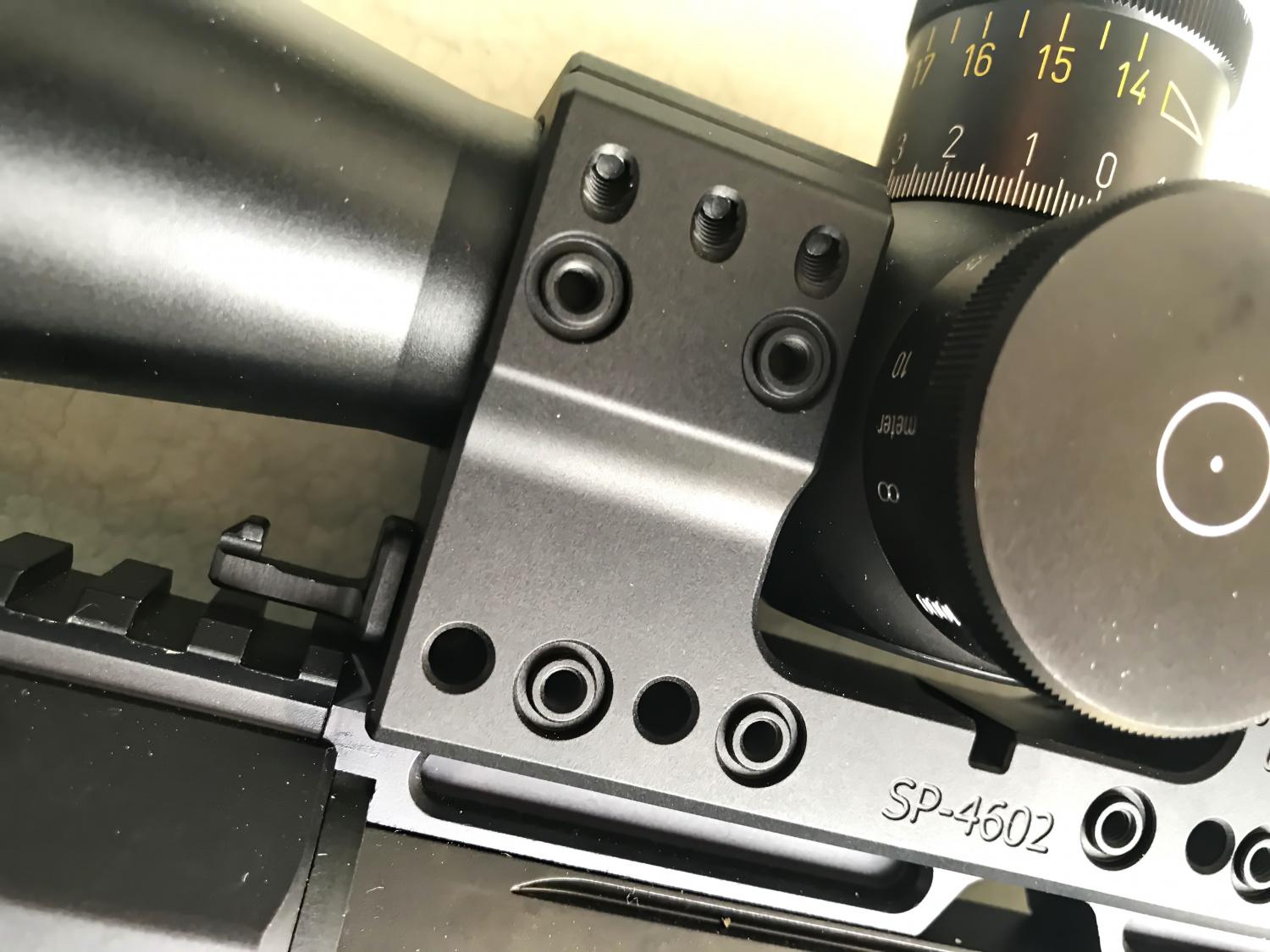
What I can recommend is that you also get a non magnified optic (Red Dot) on your riflescope for certain disciplines and hunting situations. Pick up the target in the low-profile Aimpoint Acro C-1, and engage it with the magnified optic at 20x Power. Once you’ve tried it there’s no going back, and at this level of investmen it’s only 5-600 USD more. However you must consider which turret you’re getting, so the top turret doesn’t get in the way.
You can check our review of the Spuhr interface and Aimpoint ACRO here. Just put the ACRO (or Micro) on the top of the installation instead of on the side. TFB also did a visit to Spuhr’s brand new factory.
Schmidt & Bender 5-25×56 PM II with Long Range Reticle – Milliradian (LRR-Mil)
Well, we covered the price above already and that’s a lot of money for most people to drop on a scope.
However, S&B’s pricing has actually decreased the last few years probably in an attempt from the company to be more aggressive on the market. And they have all reasons to be aggressive, as this is one of the best scopes you can buy on the market why not make it as available as possible?
It feels that S&B have somewhat of a re-boot on the commercial market, developing a lot of new products and introducing new reticles like the one tested here.
Of course, there will be people who never heard of this or that company regardless how much they spend on marketing. A funny story is my friend who just began shooting thought Schmidt & Bender were a big international company of lawyers.

Looking at the product itself, I am struggling to find any flaws with the design and the functions. The illumination control is in the way of reading the parallax adjustment, which I find a bit of a nuisance.
But the possibilities to chose the turrets and configurations you like are mostly there. The functionality and feel are great.
One improvement that S&B could do is to have an auto-shut of the illuminated reticle. If you leave it on, that’s one battery gone next time you’re going out shooting. But perhaps S&Bs main target customers (Military & Law Enforcement) don’t care for this functionality in the field?
Shooters, especially in dynamic situations where the shooter is forced into an awkward position, always want a more forgiving eye-box and that’s the case with the 5-25 PMII as well. However, the optics always remain clear and crisp and even the best have to obey the laws of optics.
The operating manual covers the essentials and comes in German and English (possibly other languages). Parts of the text is too small in my opinion, especially in the illustrations.
To cut it down into a conclusion: I never ever regretted buying a high-quality optic, and they have all stayed on any of my rifles (or cameras!). A quality optic will continue to be good over time, although better models may develop. However I have bought a few bargain scopes, but after some time I have sold them and upgraded. For me, this is valuable time lost mounting and zeroing. Perhaps your daily life and buying pattern is different, but for me, the conclusion is to save up money for what I really want, and don’t buy that half-priced scope along the line. This particular reticle may be too thin for some of you, but it’s in the name “Long Range Reticle”. For long range shooting, I can really recommend this Schmidt & Bender.

I hope you enjoyed reading this review, it’s a bit longer than I first expected but I spent a lot of time with this scope and I’m trying to include all my thoughts and experience.
Lucky Ending
Every story needs a lucky ending, and this one has it. By this spring (2019) I already had started testing and reviewing this particular scope and reticle, and it was growing one me.
I always wanted an S&B 5-25 PM II but couldn’t afford one, but I was just planning to buy my very own as soon as I had chosen which reticle to get. I entered my first real Precision Rifle Series competition, thinking it would be a great experience to try something new.
It just happens to be that Schmidt & Bender sponsors every Viking Rifles Series (Nordic Precision Rifle Series) lottery with a 5-25 PMII scope, and not just the basic model. That is quite a statement from a sponsor as there are more than 10 matches, and something we competitors should be very thankful of.

SIG 553 Commando with a S&B 1.1-4×24 Short Dot, JP Rifles with S&B 5-20×56 PMII Ultra Short (note Aimpoint Micro on top) and the tested S&B 5-25×56 PMII. Notice the different turrets on the scopes.
Feeling very confident during the awards, and as they pulled number 56 from the lottery there I was on my first PRS match winning a 3,500 USD scope (H2CMR reticle).
There’s no point in winning matches, as long as you’re lucky in the lottery! And yes, there were a few envious looks in the audience.
Many thanks to Schmidt & Bender Germany and Spuhr Sweden for letting us borrow these high-end products. We can never test everything and every aspect, but hopefully, this article can help you make a an educated purchase.
If you want to read more about Schmidt & Bender’s history please check here.
We are committed to finding, researching, and recommending the best products. We earn commissions from purchases you make using the retail links in our product reviews. Learn more about how this works.
 Your Privacy Choices
Your Privacy Choices
